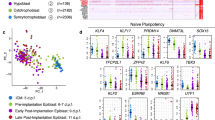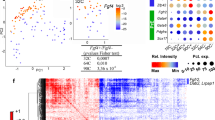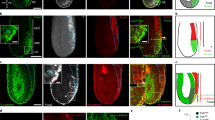Abstract
IN amniotes, all of the tissues of the adult arise from the epiblast, one of the two layers of cells present in the early embryo; the mesoderm and gut endoderm arise from an epiblast-derived structure known as the primitive streak. The monoclonal antibody HNK-11–3recognizes the cells of the primitive streak in the chick embryo4. Before streak formation, HNK-1 identifies cells that are randomly distributed within the epiblast4.We have now used two novel ways to study cell lineage and commitment to show that the epiblast of the early chick embryo contains two distinct populations of cells with different developmental fates at a stage during which 'mesodermal induction' is believed to occur. One cell population, recognized by monoclonal antibody HNK-1, is destined to form mesoderm and endoderm; the rest of the epiblast is unable to give rise to mesoderm if this population of cells is removed.
This is a preview of subscription content, access via your institution
Access options
Subscribe to this journal
Receive 51 print issues and online access
$199.00 per year
only $3.90 per issue
Buy this article
- Purchase on Springer Link
- Instant access to full article PDF
Prices may be subject to local taxes which are calculated during checkout
Similar content being viewed by others
References
Abo, T. & Balch, C. M. J. Immun. 127, 1024 (1981).
Tucker, G. C. et al. Cell Diff. 14, 223 (1984).
Rickmann, M., Fawcett, J. W. & Keynes, R. J. J. Embryol. exp. Morph. 90, 437 (1985).
Canning, D. R. & Stern, C. D. Development 104, 643 (1988).
Eyal-Giladi, H. & Kochav, S. Dev. Biol. 49, 321 (1976).
New, D. A. T. J. Embryol. exp. Morph. 3, 326 (1955).
Waddington, C. H. Wilheim Roux Arch. EntwMech. Org. 128, 502 (1933).
Eyal-Giladi, H. Cell Differ. 14, 245 (1984).
Azar, Y. & Eyal-Giladi, H. J. Embryol. exp. Morph. 61, 133 (1981).
Nieuwkoop, P. D., Johnen, A. G. & Albers, B. The Epigenetic Nature of Early Chordate Development (Cambridge University Press, 1985).
Smith, J. C. Development 105, 665 (1989).
Gurdon, J. B. Development 99, 285 (1987).
Azar, Y. & Eyal-Giladi, H. J. Embryol. exp. Morph. 52, 79 (1979).
Mitrani, E. & Eyal-Giladi, H. Nature 289, 800 (1981).
Mitrani, E. & Eyal-Giladi, H. Differentiation 26, 107 (1984).
Hamburger, V. & Hamilton, H. L. J. Morph. 88, 49 (1951).
Goodman, S. L. et al. J. Microsc. 123, 201 (1981).
Hutson, J. M. & Donahoe, P. K. Stain Technol. 59, 105 (1984).
Stern C. D. & Keynes, R. J. Development 99, 261 (1987).
Author information
Authors and Affiliations
Rights and permissions
About this article
Cite this article
Stern, C., Canning, D. Origin of cells giving rise to mesoderm and endoderm in chick embryo. Nature 343, 273–275 (1990). https://doi.org/10.1038/343273a0
Received:
Accepted:
Issue Date:
DOI: https://doi.org/10.1038/343273a0
This article is cited by
-
Developmental biology of the pancreas
Cell Biochemistry and Biophysics (2004)
-
Tracing the lineage of tracing cell lineages
Nature Cell Biology (2001)
-
Promotion of gastrulation by maternal growth factor in cultured rabbit blastocysts
Cell and Tissue Research (1995)
-
Transgenesis in chickens
Transgenic Research (1993)
-
Intermediate filament protein expression and mesoderm formation in the rabbit embryo
Roux's Archives of Developmental Biology (1992)
Comments
By submitting a comment you agree to abide by our Terms and Community Guidelines. If you find something abusive or that does not comply with our terms or guidelines please flag it as inappropriate.



